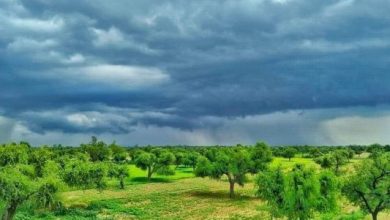
Tharparkar’s thirst is not merely a crisis of nature – it is a test of governance, accountability, and will.
- Decades of neglect and short-term interventions have left one of Pakistan’s most marginalized regions exposed to a preventable catastrophe.
Ali Nawaz Rahimoo
Water the most essential ingredient of life is under severe strain in Tharparkar. The arid district, already crippled by chronic scarcity, now faces a deadlier challenge contamination of its limited groundwater sources. This deepening crisis is endangering public health, livelihoods, and the fragile desert ecosystem that sustains more than 1.6 million people.
Receiving an average annual rainfall of just 100–300 mm, Tharparkar depends almost entirely on underground water a resource that has now become both scarce and unsafe.
 A dry land of dependence
A dry land of dependence
Spread over nearly 20,000 square kilometers, Tharparkar’s landscape is mostly desert barren, vast, and devoid of any perennial river or canal system. For centuries, communities have relied on wells and aquifers. But multiple scientific studies now show that much of this groundwater is dangerously contaminated.
A study by Mehran University of Engineering and Technology found excess fluoride in eight of nine test sites and arsenic levels exceeding safe limits at several others. Traces of lead, mercury, and selenium all above World Health Organization (WHO) standards were also detected.
Fluoride concentrations in some areas were recorded as high as 49 mg/L, compared to the WHO limit of 1.0 mg/L. Arsenic levels were found far above the permissible limit of 0.01 mg/L. Such exposure can cause dental and skeletal fluorosis, kidney failure, and irreversible bone deformities, especially among children.
Earlier, a joint study in 2010 by the Dow University of Health Sciences (DUHS), the Pakistan Council for Scientific and Industrial Research (PCSIR), and local NGO AWARE (Association for Water, Applied Education & Renewable Energy) found over 80 per cent of groundwater in Thar unfit for human consumption. AWARE’s detailed analysis of underground water (2003–2008) showed that more than half of Thar’s population used water with total dissolved solids (TDS) exceeding 5,000 mg/L, with one village in Naroowari reporting a shocking 20,000 mg/L far above the WHO limit of 1,500 mg/L.
 Broken promises of clean water
Broken promises of clean water
To address the crisis, the Sindh Public Health Engineering Department and other programs have installed thousands of reverse osmosis (RO) and ultrafiltration (UF) plants across Sindh, with Tharparkar hosting the largest number. Yet, official reports and independent monitoring reveal a grim reality: only about 101 RO plants are functional, while hundreds remain out of order due to poor maintenance, lack of spare parts, and irregular power supply. For most households, this failure means that daily life remains unchanged. Women and children still walk long distances to fetch water from deep wells, often waiting hours as the water level recedes. Many continue to drink untreated, contaminated water because nearby filtration units are broken or abandoned.
The human cost of neglect
In the village of Vohari, Soni, a mother of three, shares her daily struggle:
“We drink from the same well our animals use. My children often suffer from stomach illness, and I have constant pain in my joints.”
Her story echoes across Thar, where groundwater once a lifeline has become a slow poison. Health workers confirm that fluorosis, once rare, is now common across many union councils. Cases of kidney and skin diseases are on the rise.
Another resident, Marvi, Village Khayari from a village 20 km from Chachro, said:
“We still walk more than 30 minutes to collect water from the only dug well. When the water level drops, we wait three or four hours for it to refill. We have been nomads for centuries nothing has changed.”
Beyond nature: human fingerprints
While Thar’s geology naturally contains high fluoride, experts warn that the presence of arsenic, mercury, and lead suggests an added human dimension. Environmentalists point to coal-mining operations, industrial waste, and poor disposal practices as possible contributors to the pollution of aquifers.
With the expansion of the Thar Coal Project, independent and transparent water testing is urgently required to distinguish natural contamination from industrial pollution and to ensure accountability.
 Urgent priorities
Urgent priorities
Experts and activists recommend a combination of immediate and long-term actions:
- Emergency access: Expand water trucking, mobile filtration units, and household filters while non-functional plants are repaired.
- Public health response: Launch medical screening for fluorosis and heavy-metal exposure, and raise awareness about safe water use.
- Accountability and regulation: Enforce environmental safeguards on industry and ensure transparency in public water projects.
- Sustainable solutions: Promote rainwater harvesting, solar-powered filtration, managed aquifer recharge, and community-led maintenance instead of one-time installations.
- Government commitment: Develop “sweet water” aquifers, invest in defluorination and desalination plants, and ensure reliable oversight of existing infrastructure.
A test of governance
Tharparkar’s thirst is not merely a crisis of nature – it is a test of governance, accountability, and will. Decades of neglect and short-term interventions have left one of Pakistan’s most marginalized regions exposed to a preventable catastrophe. Without decisive, transparent, and community-driven action, Thar’s silent suffering will only deepen one poisoned well at a time. But with political commitment and innovation, this tragedy could yet become a story of resilience and a reminder that water is not a privilege, but a fundamental human right.
Read: Deforestation Accelerates Desertification in Thar
_________________
 Ali Nawaz Rahimoo, based in Umerkot, Sindh is a social development professional. He can be contacted on anrahimoo@gmail.com
Ali Nawaz Rahimoo, based in Umerkot, Sindh is a social development professional. He can be contacted on anrahimoo@gmail.com





Thar desert undergrad water is not fit human consumption as per world health organization (WHO) standards. 21 centery thari people still collect water from dug wells and hand pumps. Water is precious in thar. Government should provide the drinking water immediately basis.
Women and children in Thar are forced to collect water from distant or unsafe sources. The government should take urgent steps to provide safe and reliable drinking water facilities in the region.